Fascinating Rhythm.
Those of you who have followed my travels through these posts have probably observed that I try to deal with the potential for jet lag by pushing hard through the first day and trying not to sleep until the time at my location is close to a normal bed time. I did the same on this trip despite the fact that my schedule was entirely my own and if I’d wanted to sleep Thursday away no one would have been the wiser. But that wasn’t the case. I fell into bed about 22:00 Wednesday and woke at an unexpectedly dark 07:30.
Before I left for this trip, I’d told my pal Doctor BK that I expected the rhythm of my days in Lisboa to be noticeably different from the pace and pulse of my days at home. At home, my days typically begin with tea, Washington Post puzzles, and scanning the print edition of that paper. While a morning cuppa was certainly likely, any interaction with WaPo would have to happen online and I really don’t like to start my day on the computer.
One daily rhythmic change I hadn’t anticipated was the relative difference in sunrise and sunset in the two cities. In Lisboa, the sun rises (and sets) about half an hour later than in the Washington area (the DMV). This is clearly a result of how the time zone maps are drawn longitudinally because the two cities are nearly at the same latitude.
(Lisboa is at 38.7223° N and Washington, DC is at 38.9072° N – a difference of 20.5 kilometers or about 13 miles. For my suburb of Silver Spring, that difference is .3192° latitude which translates to 35 km or 22 miles relative to Lisboa. Surprisingly, though, Lisboa has a much milder average climate than the DMV as this graph from weathersparkÂ
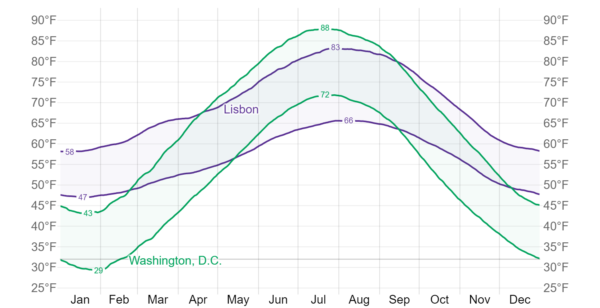
shows.)
Thus, while my day in Maryland typically begins between 07:15 and 07:30, in Lisboa, the darker mornings resulted in me rolling out of bed closer to 08:00.
Although the intent of this trip was primarily an experiment in two weeks living in Lisboa, the city remains new to me and it still housed many places I wanted to visit that I wasn’t able to see on my first trip here. After my morning tea, the first order of business was to go to the grocery store to stock the kitchen for my New Year’s Eve dinner. (I planned to eat in because, with only two days until the holiday, I knew the likelihood of finding a nearby restaurant with a free table was minimal and many restaurants serve a prix fixe menu. New Year’s Eve is a very busy restaurant night in Lisboa.)
I was able to fill my basket with enough fresh and canned goods, bread, and eggs
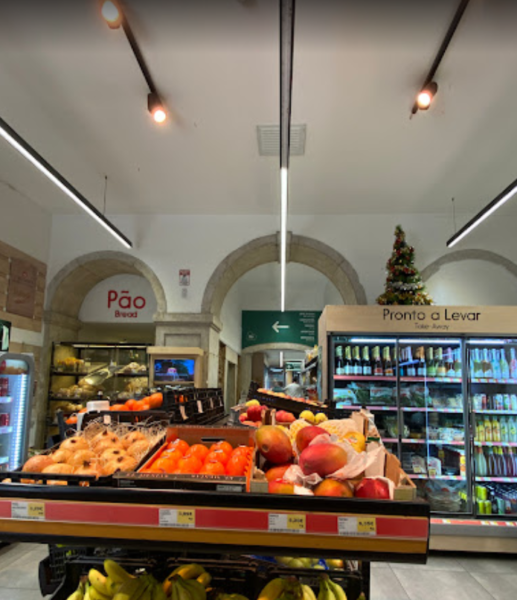
to set myself up for dinner (with leftovers) and breakfast for several days. I returned to the flat, sat down at the computer, and scribbled a plan for the day on a scrap of paper that I slid into a pocket.
By the time I’d finished my shopping, planning, and web surfing it was late enough in the morning that a walk to Cais do Sodre and the Mercado da Rebeira (aka Time Out Market) (about 1,500 meters) seemed to be the logical next step. The market has two distinct sections. The actual market
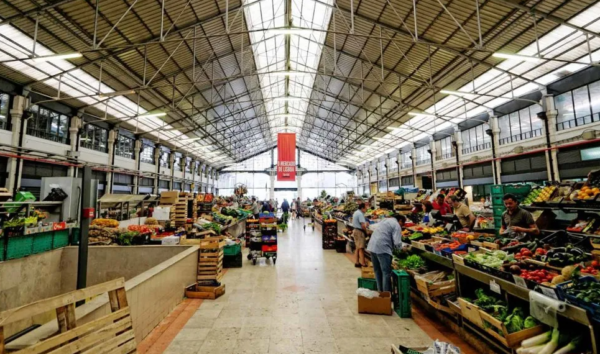
and the Time Out section filled with almost every type of restaurant imaginable. Although it was only a bit after 11:00 when I arrived, the restaurant and table space was impossibly crowded with lines of people nearly everywhere. (I’ll add that, although the tourist guides tout a visit here, just glancing at the prices it struck me that one could eat just as well and more economically elsewhere.)
Based on the combination of the crowd and the prices, I decided to pass on having an early lunch there but did stop at a branch of Manteigaria – famous for their Pasteis de Nata – for two of the sweet treats and to try a cup of Portugal’s equivalent to espresso that’s called bica in Lisboa but might also be simply cafĂŠ in the rest of the country. Ever the tea drinker, I’m unlikely to ever develop a taste for, let alone match, the Portuguese passion for bica.
A story of coffee, bica, and acronyms.
In the post called Me and my Chiado, I briefly mentioned the famous cafĂŠ A Brasileira that Adriano Telles opened on 19 November 1905. It was Lisbon’s first coffeehouse and Telles’ second having opened one with the same name in Porto in 1903.
Coffee was first cultivated in what is today Ethiopia where tribesmen ground coffee cherries and bound them together with animal fats to provide an energy boost while hunting. In the late 14th or early 15th century, traders crossed the Red sea to the city of Mocha in Yemen which then became the center of the coffee trade.
The Great Siege of Malta by the Turks in 1565 helped spread the beverage into mainland Europe where Venetian traders and merchants accelerated the process. Over the next century hundreds of coffee shops opened throughout the various kingdoms that comprise present day Italy.
Although the Brazilian climate was favorable for growing coffee, and the Portuguese “discovered” the area in 1500, they didn’t start cultivating the crop – using mainly slave labor – until 1727 but once they’d started, you’d find an awful lot of coffee in Brazil.
Meanwhile, the Ottomans spread their tradition of the coffeehouse as they conquered much of Eastern Europe. The first coffeehouse in England opened in Oxford in 1652 and in London just months later. Within three decades England had more than 3,000 coffeehouses including one where the insurer Lloyd’s of London had its own origin.

(Photo from londonist)
But the idea of the coffeehouse was slow to reach Portugal on the continent’s southwestern edge.
Into this void, stepped Adriano Telles. Telles had emigrated with his family to Minas Gerais in southeastern Brazil at age 12. He married the daughter of wealthy coffee farmers and became himself a successful farmer. Then he returned to Portugal early in the 20th century where he established a coffee import business and created his own style of roast that he called “a Brasileira.”
Telles was a savvy marketer who employed several strategies to help the Portuguese – who liked the sweetness of their port wine – overcome the natural bitterness of coffee including offering a free cup of coffee at his counter to anyone who bought a kilo or more of his Brazilian roast. He handed out leaflets showing how to prepare the coffee and hired people to paint “O melhor cafĂŠ ĂŠ o d´A Brasileira” {The best coffee is from A Brasileira} on bare walls and abandoned buildings around the city.
With his coffeehouse in Porto established, he expanded south and opened a second shop in Lisboa. Within a short time according to the history on its website, A Brasileira was established as “a rendezvous point for the great and the good of the day: lawyers, doctors, teachers, writers, and artists. It was also a meeting point for revolutionaries who eventually took part in establishing the Republic in 1910.” This included the great writer Fernando Pessoa,
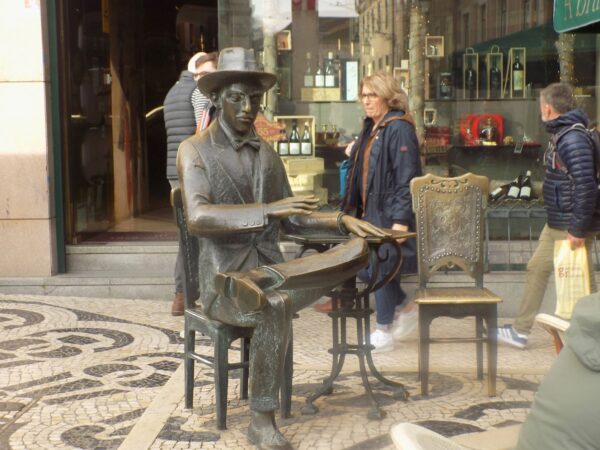 who is honored with this statue outside the cafĂŠ.
who is honored with this statue outside the cafĂŠ.
If you order a cafĂŠ in Portugal, you’re almost certain to get the espresso like beverage served in a cup like this.
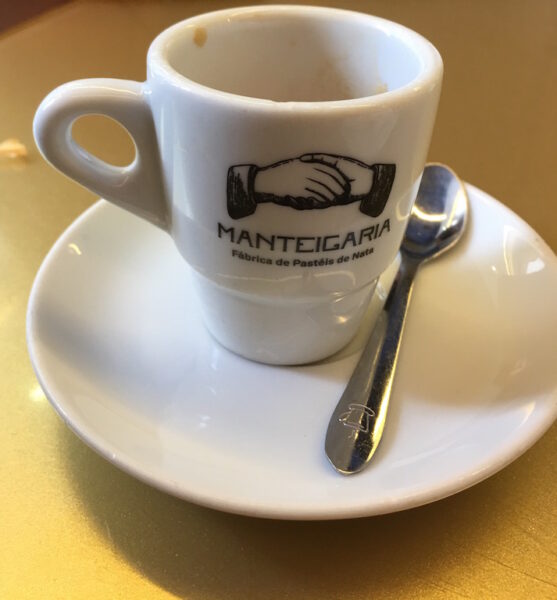
In Lisboa and much of the south of the country, you should order a bica. There’s a bit of controversy regarding how the name bica became attached to the drink. Some claim that to offset the natural bitterness, roasters used signs that read, “Beba Isso Com Açúcar” (Drink it with sugar) and Lisboetas began applying the acronym.
However, I’m something of an acronym skeptic for any coinage prior to World War 2 and my friend Ana supplied a more believable explanation. (Although one could claim that the first known acronym dates to the ancient Greek use of ichthys – IisoĂşs ChristĂłs, theoĂş huios sĹtÄr – to refer to Jesus, the first known acronym in English was Walter P Phillips’ telegraphic use of SCOTUS in 1879 but this coinage method didn’t become common until WW II with terms like AWOL and SNAFU.) Ana told me the origin describes the way the coffee flows, directly falling from the machine to the cup on the tray. This can be seen as analogous the the flow from a water spring or fountain – either of which can be called bica in Portuguese. It’s also possible that the nib like appearance of the spout reinforced that perception since bico can also refer to a bird’s beak. (In Lisboa, if you want a more traditional American style, you should order cafĂŠ da panela {coffee from the pot}. Other terms might be cafĂŠ americano or cafĂŠ de saco or simply cafĂŠ. One alert: When visiting, though, be certain you order bica and not bico as the latter is also Portuguese slang for fellatio.)
With this caffeinated detour done, I’ll return to my first full day in Lisboa in the next post.
To say I’ve learned something new from reading your post is a massive understatement, as always. I enjoyed your opening about your daily rhythm observations but things got fun when you entered into Bica territory. Love your inclusion of the beginnings of coffee and it’s migration into the main stream
If we still had a signature line over at TT, this would be one of mine.
“One alert: When visiting, though, be certain you order bica and not bico as the latter is also Portuguese slang for fellatio.)”
I actually belly laughed. Unexpected but muito apreciado meu amigo.
Lastly, iirc, there is a song contest going on and this post contains 2?
Obrigado amigo. As for the song contest, yes. Two in this post and five in yesterday’s. I’d tab yesterday’s as relatively easy. Today had one easy and one difficult one.
I have 4 guesses so for 3/1 and I think I nailed the 2 for this one. Would love to win some money for charity.
Congratulations. I’ll be surprised if you have both from today. I hope you’re right. But I’ll be surprised.
I believe I got all 5 from yesterday, and I think I have 1 for today, but today’s are far less obvious. The game is afoot!
from Excellent GIFs via Gfycat
Some will be easy. Some will be hard. Some will be barely discernable.